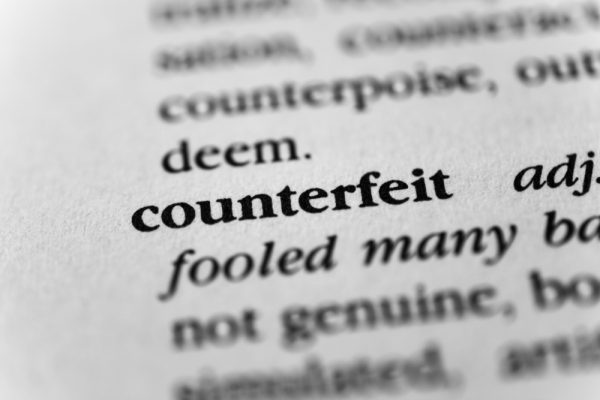
It shouldn't really come as much of a surprise, but China has come out as the top producer of counterfeit goods, according to a global analysis.
The Asian country has been given the title in nine out of 10 product sectors vulnerable to counterfeiting that were analysed by the Organisation for Economic Co-operation and Development (OECD) and the EU Intellectual Property Office (EUIPO).
Revealed in the report Mapping the Real Routes of Trade in Fake Goods, the study also discovered that Hong Kong (an autonomous territory of China), the United Arab Emirates and Singapore were global hubs for the trade in counterfeit goods.
The analysis aimed to establish the origin and transit points of fake goods based on customs seizure data, and reviewed 10 main sectors – including food, pharmaceuticals, cosmetics, leather and handbags, clothing, footwear, jewellery, electronics, photographic and medical equipment, toys and sports equipment. Together these sectors account for $284bn in 2013 (€208bn in 2013), more than half of the total estimated trade in fake goods.
"Parties that engage in the trade of counterfeit and pirated products tend to ship infringing products via complex routes, with many intermediary points… in order to cover their tracks," the report said.
"The transit points are used to i) facilitate falsification of documents in ways that camouflage the original point of departure, ii) establish distribution centres for counterfeit and pirated goods, and iii) repackage or re-label goods."
According to the findings, China and Hong Kong together as source countries accounted for more than 80 per cent of the seizures made by other countries during 2011-13.
Besides China, other Asian countries including India, Thailand, Turkey, Malaysia, Pakistan and Vietnam were highlighted by the report as important counterfeit producers for many product sectors, "although their role is much less significant than China's."
Meanwhile, analysis of customs seizure data identified Hong Kong, the United Arab Emirates and Singapore as the main transit points for all 10 product categories where "fake goods arrive in large quantities in containers and are sent further in small parcels by post or courier services," the report said.
The analysis also identified important regional transit points. For instance, Middle Eastern countries including the UAE, Saudi Arabia and Yemen, are transit points for sending fakes to Africa, while Albania, Egypt, Morocco and Ukraine are transit points for redistributing fakes to the EU. And Panama is an important transit for fakes en route to the USA.
Many distribution hubs are in countries with "weak governments and a strong organised crime presence," the report added.
A large number of regional and sector-specific patterns were also uncovered in the study. Turkey, for example, appears to be an important producer in some sectors – such as leather goods, foodstuff and cosmetics – which are sent by road to the EU.
In terms of product categories, China, India and several other smaller Asian countries are the main producers of counterfeit food, exporting directly to the US, the EU, Japan, Western and Northern Africa and Yemen, as well as indirectly via Gulf region states.
India leads with China closely behind as the largest producers of counterfeit pharmaceuticals, which they ship all around the globe, with a special focus on African economies, Europe and the US. Hong Kong is one of the most important transit points for fake meds largely using postal services.
Shipments with fewer than ten items accounted for about 43 per cent of all shipments, the report found. "The data show that small shipments and parcels tend to dominate numerous trade routes, reflecting the shrinking costs of postal and courier shipments and the increasing importance of Internet and e-commerce in international trade." Small shipments also reduce the risk of bulk losses in the event of interception, it added.
Goods in transit are less likely to be intercepted as they tend not to be targeted by local enforcement authorities, the report noted.
"Globalisation, trade facilitation, and the rising economic importance of intellectual property are drivers of economic growth. However, they have also created new opportunities for criminal networks to expand the scope and scale of their operations, free-riding on intellectual property and polluting trade routes with counterfeit goods," António Campinos, executive director at EUIPO and Rolf Alter, director, OECD/GOV, said.
They added: "The complexity of the routes of trade in fakes can be a formidable obstacle for enforcement authorities. Precise information about the routes of trade in counterfeit goods is essential for tailoring effective governance responses to this scourge."
The study to chart the routes of trade in fake goods was conducted to provide policy makers with robust empirical evidence about the counterfeit threat.
"The broadening scope and magnitude of counterfeiting and piracy are key challenges in the global economy… We are confident that this research will make a major contribution to the understanding of trade in counterfeit and pirated goods. We trust that it will help governments develop targeted policy responses and strengthen governance frameworks to tackle this phenomenon."
The report also called for more in-depth analysis for the development of efficient enforcement and governance frameworks in three areas, including: the role of free trade zones in transhipments; the detection problem posed by small shipments; and the economic features of provenance economies, including the quantitative relationship between the intensities of counterfeiting and indices of free trade, quality of governance, and public sector integrity.
The customs seizures data was provided by the World Customs Organization (WCO) and was supplemented with regional data submitted by the European Commission's Directorate-General for Taxation and Customs Union, the US Customs and Border Protection Agency and the US Immigration and Customs Enforcement.
Last year, the OECD and EUIPO published a report mapping the economic impact of the illicit trade, which revealed that counterfeit and pirated goods amounted to up to 2.5 per cent of world trade in 2013 and accounted for 5 per cent of imports into the EU.
©
SecuringIndustry.com





